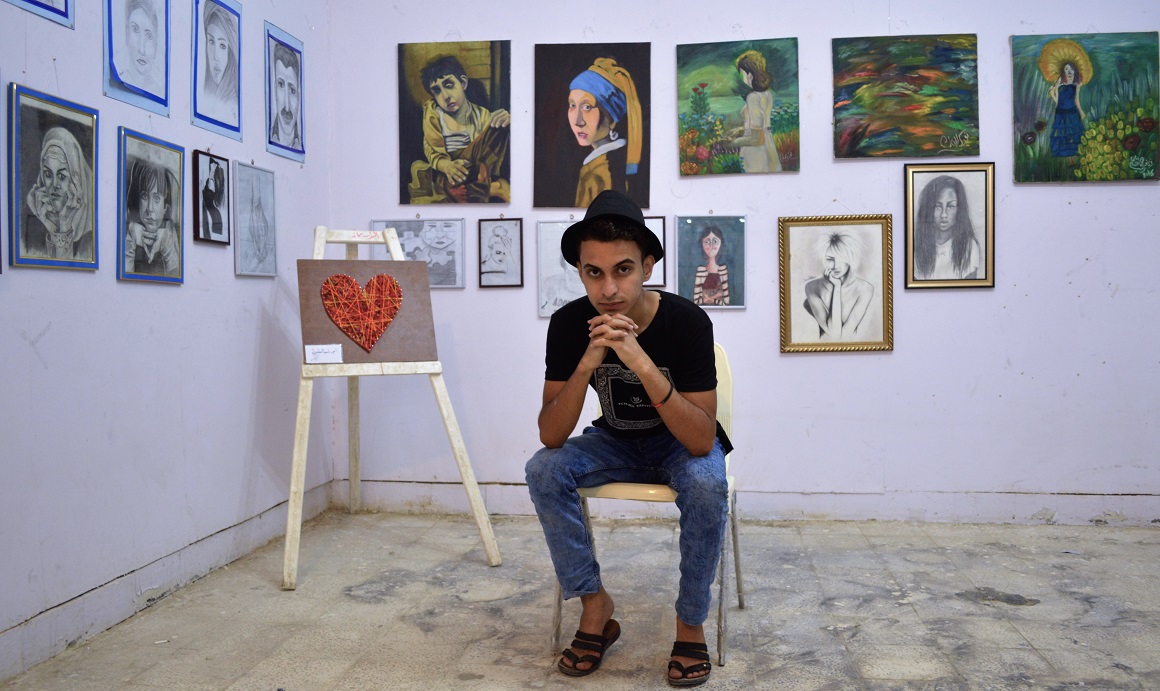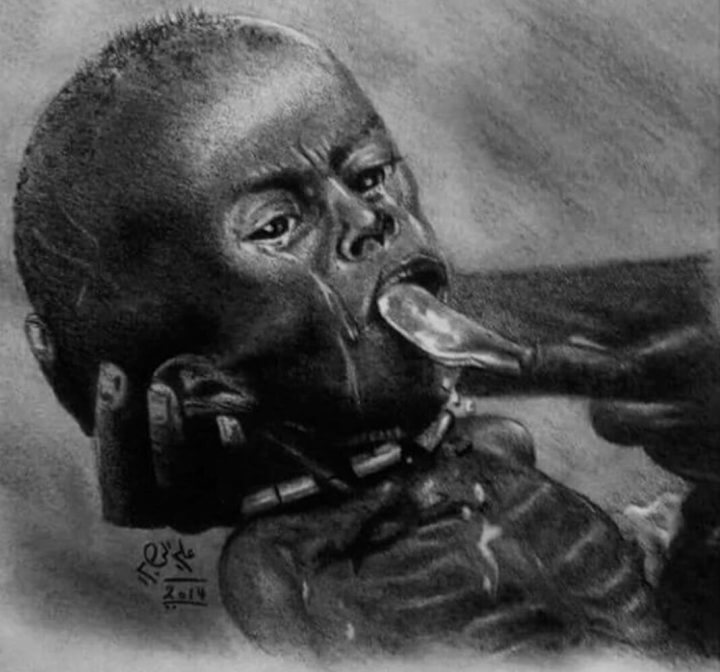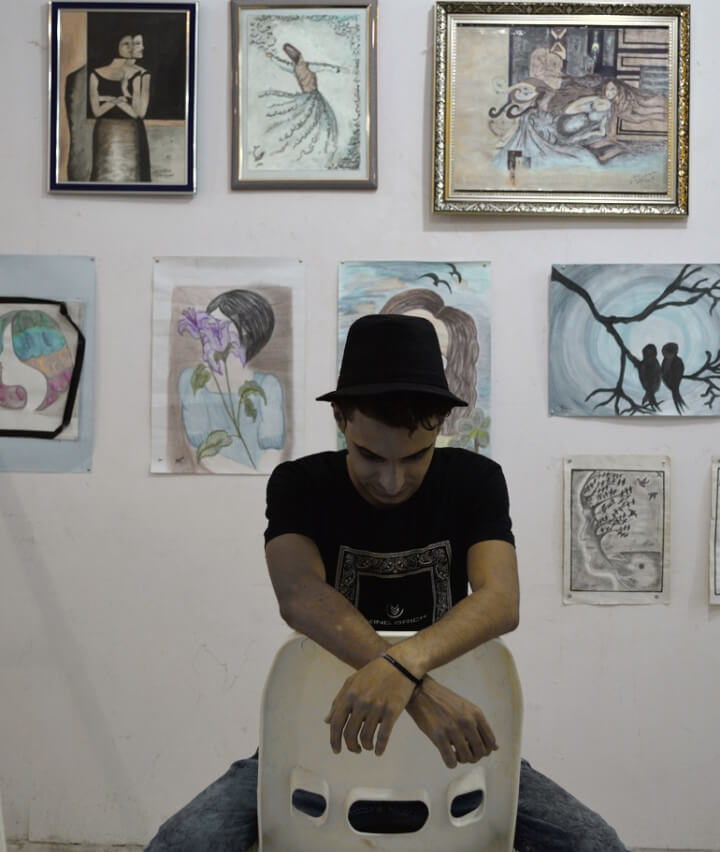On a warm Autumn evening in central Iraq, Hawraa Adnan visited the Arts Palace of Diwaniya and caught up with up-and-coming artist Hasanin Sadeq to talk ambition, creative influences, and Iraq’s art scene…

Iraqi artist Hasanin Sadeq makes social statements through art. Image: Hawraa Adnan
Like many in Iraq, Hasanin Sadeq is no stranger to the tumult and uprooting that comes with war.Born and raised in Baghdad, the 18-year-old migrated with his family to Diwaniya in the wake of the capital city’s dangerous conditions.
With a new home came stability and new stomping grounds, the avid drawer quickly became a regular at the Arts Palace in Diwaniya, which holds drawing classes for students aged 15 to 25 years and showcases their work in a Gallery at the end of each term.
Hasanin’s art pieces are on exhibit when I meet him at the Art Palace, so he gives me the grand tour of the gallery.
“Can you guess where mine are?” he asks, half-jokingly, as I look around, taking it all in. I am amazed at the profound work before me and a bit surprised by their contents. I had expected to find many more political works on display, as was the case with other Iraqi art exhibitions I had previously visited.
Instead, I sensed a theme of great sadness in a lot of the work exhibited at the Art Palace Gallery.
Hasanin points out some of his work, and the melancholy is so overt that I can correctly guess a couple more of his drawings.
When did you know you wanted to be an artist?
From childhood. My father always encouraged me. He is an artist and he always supported and shared his skills with me.
I started getting many compliments for my work, and by people who had already made a name for themselves as artists. These artists gave me constructive criticism and this has helped my skills immensely .
By the time I was 14, I just knew this was my life path.
Your parents must be very proud, especially your dad!
Most of the encouragement i have received has been from my parents. They bought me pencils and tools and nurtured my skills.
I can’t help but feel immense sadness in your drawings. Can you tell me about that?
Yes. In times of turmoil, I grab a paper and pencil and release what is inside me. And there is a lot of sadness. There is always sadness. I have had a lot of difficult times; in school, with my family. I felt so distant from my parents and friends. The art community has helped me develop a better social life and provide an outlet for my emotions.
Tell me about your drawing process.
I always start late – at least 3.00 a.m. This is when I feel most at peace.
I organise my pencils and get comfortable. I then start with a stroking motion as the image develops and I continue for a few hours until I feel satisfied enough to take a rest.
If I’m not drawing at home, I would be at the Palace, with a group of friends. We draw together.
What kind of art do you like to emulate?
My favourite types of art works are siryali (surrealism), ta’beery (expressionism) and ramzy (symbolic). I follow a lot of these works and employ the techniques into my own pieces.
I am also inspired by one of our local art teachers, Ali Al-Rakabi. His attention to detail is a goal I would like to achieve in my own work. I am proud to say that I attended his class and ranked number one by the end!

Artwork by Ali Al-Rakabi.
Well done! What are your all time favourite art works?
The Mona Lisa, of course!
I also love The Scream (Edvard Munch), The Nightwatch (Rembrandt) and Van Gogh’s The Starry Night. I love Da Vinci’s work too.
Can you tell me a bit about this exhibition? Tell me about your class mates’ work that is presented here.
I don’t like politics, but as you look around, you can see a lot of local politics presented in the drawings. Social justice issues are too important to ignore. Two of our biggest issues right now are tribalism and gender inequality. It’s the tribalism that leads to the latter.
Can you help us understand what kind of tribalism you are talking about?
In Iraq, tribes have a lot of influence and power over the small and big issues. Their power extends right up to the parliament. I have taken part in drawing about our tribal issues, especially on the state of women’s freedom’s in Iraq. One of our own female classmates was removed from our class by her parents who thought this wasn’t an appropriate setting for her. I strongly disagree with this. I want to say that I disagree with this through my art. I believe in equality.

Ahlul-bayt art historically depicts Shia saints in romanticised ways and evokes notions of hope, sometimes accompanied by motivational texts. Artwork: Mahmoud Farshchian.
Can you tell me about Iraqi art in general?
As you can imagine, there is a lot of politics in Iraqi art. Entire exhibitions have shown paintings depicting the militarised culture of Iraq and its lasting impact. As Iraqis, we have a lot to express about war.
Another emerging theme in Iraqi art is Ahlul-bayt art. People are expressing their ideas of Ahlul-bayt in incredibly creative ways. This trend is also influencing people’s interest in calligraphy and calligraphy art. I like to see more variety in the Iraqi art scene.
How does the public perceive the art community?
There is a great vibe here, because there is all kinds of emerging talent and creativity, and it is turning local’s heads! There is always something on in Diwaniya from the arts community; plays, exhibitions, and classes are regularly hosted here. Artists have put their heart and soul into the work even before the increase of public interest. People are feeling inspired; it’s exciting.
That sounds great! What about the set backs?
The first thing is that we are always ill equipped, and that includes educational institutions which lack funding. There is also inflation in the prices of the tools we need. An item that is worth $3.00 internationally sells for $15.00 in Iraq. Businesses have created a price hike and the government doesn’t care. There are artists who skip their classes to make ends meet. We feel alone in this struggle. We are very lucky when we manage to sell our art.
The second issue is the corruption we have in our system where an unqualified person is given a position that should be reserved for someone who worked for it and is qualified. As you may know this is a huge problem in Iraq, and even extends to the art scene.
Thirdly, and to a lesser extent, is the criticism we receive that we should do something better with our time. It doesn’t help anyone. I need for people to accept that I will do this, and then what they can offer me is constructive criticism so I can better myself.
What do you think can help young artists?
We need our government to make an appearance and help, because we need more spaces for artists. We need better equipment, especially in educational institutions. We need more accessible tools. Networking would be greatly beneficial also, so we would like some exposure so we know who we can connect with.
How do Iraqi artists get exposure and communicate with each other?
Each of us creates a public Facebook profile and Instagram, and this is how we expose our work and connect with each other. Facebook is our biggest and most useful platform.
What’s next for you?
I am going to The College of Fine Arts in Baghdad, and until college starts, I will continue to attend drawing classes here.
Where do you see yourself in 10 years?
On exhibition in the galleries of Baghdad. I want people from all over to come to visit my work, inshallah! This is my dream. Once I achieve this dream, I would love to be an arts teacher and give back to my community.
Some day, I want people to be so proud of me that they will say, “He is our son!”.
Follow Hasanin on Instagram to see more of his creative work.
By Hawraa Adnan
Hawraa is currently on a personal journey of rediscovering Iraq through art, food and scholarship. Find her on Instagram!









Reblogged this on cafsha.
Like Like